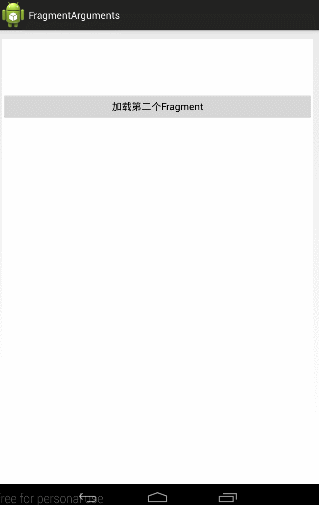今天总结一下Fragment间的参数传递及结果返回的方法。
效果图:
1、点击“加载第二个Fragment按钮”,加载出第二个Fragment,同时传递过去参数:“从Fragment1传来的参数”这几个String;
2、当用户点击第二个Fragment中的几个图片时,将点中的结果返回给第一个Fragment,将用户的选择在第一个Fragment显示出来
一、基本架构搭建
首先,我们要把整个架构搭起来,然后再进行参数传递和回传
(一)、基本XML构建:
根据上面的效果,大家很容易看到两个Fragment的布局:
1、Fragment1的布局:(fragment1.xml)
很简单,垂直布局,上面一个ImageView来盛装返回过来的图片结果,下面一个Button来用来点击加载第二个Fragment;
- <LinearLayout xmlns:android="http://schemas.android.com/apk/res/android"
- android:layout_width="match_parent"
- android:layout_height="match_parent"
- android:background="#ffffff"
- android:orientation="vertical">
- <ImageView
- android:id="@+id/img_result"
- android:layout_width="100dp"
- android:layout_height="100dp"
- android:scaleType="center"/>
- <Button
- android:id="@+id/load_fragment2_btn"
- android:layout_width="fill_parent"
- android:layout_height="wrap_content"
- android:text="加载第二个Fragment"/>
- </LinearLayout>
这个也是垂直布局,上面的一个TextView用来盛装从Fragment1传过来的String参数,下面的几个ImageView用来显示几个供用户选择的图片
- <LinearLayout xmlns:android="http://schemas.android.com/apk/res/android"
- android:layout_width="match_parent"
- android:layout_height="match_parent"
- android:background="#ffffff"
- android:orientation="vertical">
- <TextView
- android:id="@+id/textview"
- android:layout_width="wrap_content"
- android:layout_height="wrap_content"
- android:text="This is fragment 2"
- android:textColor="#000000"
- android:textSize="25sp" />
- <ImageView
- android:id="@+id/img1"
- android:layout_width="100dip"
- android:layout_height="100dp"
- android:scaleType="center"
- android:src="@drawable/animal1"/>
- <ImageView
- android:id="@+id/img2"
- android:layout_width="100dip"
- android:layout_height="100dp"
- android:scaleType="center"
- android:src="@drawable/animal2"/>
- <ImageView
- android:id="@+id/img3"
- android:layout_width="100dip"
- android:layout_height="100dp"
- android:scaleType="center"
- android:src="@drawable/animal3"/>
- <ImageView
- android:id="@+id/img4"
- android:layout_width="100dip"
- android:layout_height="100dp"
- android:scaleType="center"
- android:src="@drawable/animal4"/>
- </LinearLayout>
(二)对应的Fragment类
1、在MainActivity初始化时,将Fragment1显示出来:
MainActivity对应的XML文件:(main_activity.xml)
- <RelativeLayout xmlns:android="http://schemas.android.com/apk/res/android"
- xmlns:tools="http://schemas.android.com/tools"
- android:id="@+id/main_layout"
- android:layout_width="match_parent"
- android:layout_height="match_parent"
- tools:context=".MainActivity">
- <TextView
- android:text="@string/hello_world"
- android:layout_width="wrap_content"
- android:layout_height="wrap_content" />
- </RelativeLayout>
- public class MainActivity extends Activity {
- @Override
- protected void onCreate(Bundle savedInstanceState) {
- super.onCreate(savedInstanceState);
- setContentView(R.layout.activity_main);
- Fragment1 fragment1 = new Fragment1();
- getFragmentManager().beginTransaction().replace(R.id.main_layout, fragment1).commit();
- }
- }
2、Fragment1:在用户点击时,将fragment2添加到当前页面显示出来;
- public class Fragment1 extends Fragment {
- @Override
- public View onCreateView(LayoutInflater inflater, ViewGroup container,
- Bundle savedInstanceState) {
- View view = inflater.inflate(R.layout.fragment1, container, false);
- Button btn = (Button)view.findViewById(R.id.load_fragment2_btn);
- btn.setOnClickListener(new View.OnClickListener(){
- @Override
- public void onClick(final View view) {
- Fragment2 fragment2 = new Fragment2();
- FragmentTransaction transaction = getFragmentManager().beginTransaction();
- transaction.add(R.id.main_layout, fragment2);
- transaction.addToBackStack(null);
- transaction.commit();
- }
- });
- return view;
- }
- }
3、Fragment2:至于目前的它还是很简单的,只要能显示出来 就好了,所以他的代码为:
- public class Fragment2 extends Fragment implements View.OnClickListener {
- @Override
- public View onCreateView(LayoutInflater inflater, ViewGroup container, Bundle savedInstanceState) {
- View view = inflater.inflate(R.layout.fragment2, container, false);
- return view;
- }
- }
二、Fragment间参数传递
至于Fragment间参数为什么要用SetArguments来传递,我就不讲了,看这篇文章:《Android解惑 - 为什么要用Fragment.setArguments(Bundle bundle)来传递参数》,我这里只说项目中如何使用:
在Fragment2中,新建一个函数:newInstance(String text)来接收传过来的参数:
新建一个Fragment2实例,然后将参数通过SetArguments设置到其中;
- public static Fragment2 newInstance(String text) {
- Fragment2 fragment = new Fragment2();
- Bundle args = new Bundle();
- args.putString("param", text);
- fragment.setArguments(args);
- return fragment;
- }
- public View onCreateView(LayoutInflater inflater, ViewGroup container, Bundle savedInstanceState) {
- View view = inflater.inflate(R.layout.fragment2, container, false);
- if (getArguments() != null) {
- String mParam1 = getArguments().getString("param");
- TextView tv = (TextView)view.findViewById(R.id.textview);
- tv.setText(mParam1);
- }
- return view;
- }
- public class Fragment1 extends Fragment {
- @Override
- public View onCreateView(LayoutInflater inflater, ViewGroup container,
- Bundle savedInstanceState) {
- View view = inflater.inflate(R.layout.fragment1, container, false);
- Button btn = (Button)view.findViewById(R.id.load_fragment2_btn);
- btn.setOnClickListener(new View.OnClickListener(){
- @Override
- public void onClick(final View view) {
- Fragment2 fragment2 = Fragment2.newInstance("从Fragment1传来的参数");
- FragmentTransaction transaction = getFragmentManager().beginTransaction();
- transaction.add(R.id.main_layout, fragment2);
- transaction.addToBackStack(null);
- transaction.commit();
- }
- });
- return view;
- }
- }
(三)、从Fragment2向Fragment1回传参数
这里只有利用回调,有关回调传递参数的问题,我在前一篇文章中: 《详解Dialog(三)——自定义对话框视图及参数传递》 第三部分:参数传递;详细讲过,大家可以先看源码,如果源码不懂,可以参考下这篇文章,这里就不再赘述。源码地址:http://download.csdn.net/detail/harvic880925/8484149
请大家尊重原创者版权,转载请标明出处:http://blog.csdn.net/harvic880925/article/details/44131865
